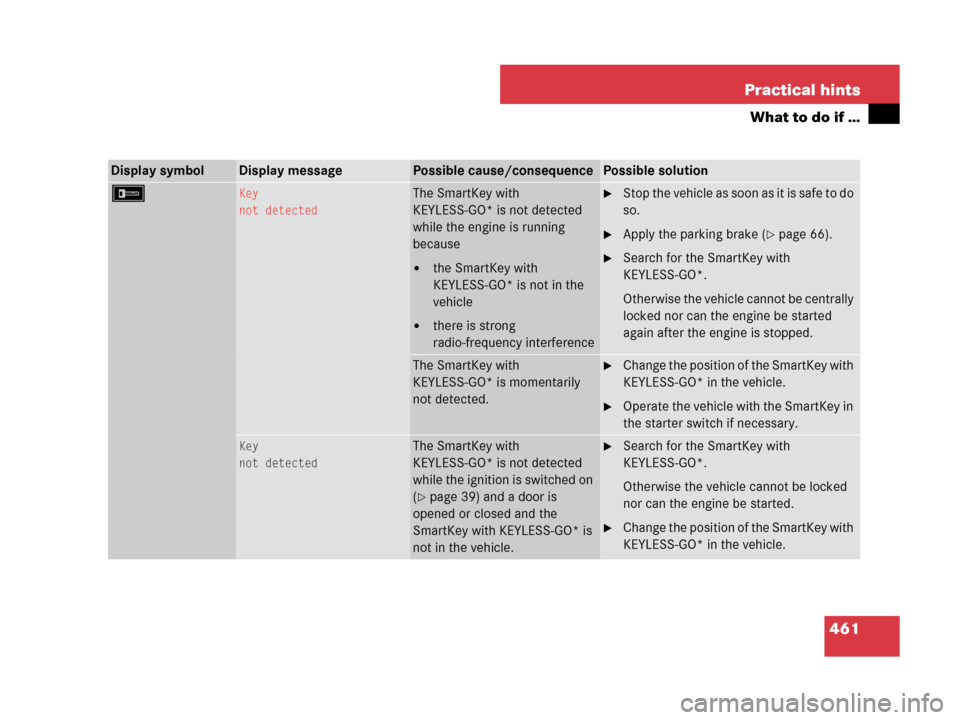Page 413 of 570

412 Operation
Vehicle care
Engine cleaning
Prior to cleaning the engine compartment
make sure to protect electrical compo-
nents and connectors from the intrusion of
water and cleaning agents.
Corrosion protection, such as MB Anticor-
rosion Wax, should be applied to the en-
gine compartment after every engine
cleaning. Before applying, all control link-
age bushings and joints should be lubricat-
ed. The poly-V-belt and all pulleys should
be protected from any wax.
Vehicle washing
In the winter, thoroughly remove all traces
of road salt as soon as possible.
When washing the vehicle underbody, do
not forget to clean the inner sides of the
wheels.Hand-wash
Do not use hot water or wash your vehicle
in direct sunlight.
�Only use a mild car wash detergent,
such as Mercedes-Benz approved Car
Shampoo.
�Thoroughly spray the vehicle with a dif-
fused jet of water.
Direct only a very weak spray towards
the ventilation intake.
�Use plenty of water and rinse the
sponge and chamois frequently.
�Rinse with clean water and thoroughly
dry with a chamois.
Do not allow cleaning agents to dry on
the finish.Automatic car wash
You can have your car washed in an auto-
matic car wash from the start. Automatic
car washes without brushes are prefera-
ble.
�To protect the filter system, switch the
climate control system (
�page 218) or
the automatic climate control system*
(
�page 232) to air recirculation mode.
If the vehicle is very dirty, prewash it
before running it through the automatic
car wash.
iVehicles with KEYLESS-GO*:
If a door handle is hit by a strong jet of water, and
a SmartKey with KEYLESS-GO* is in close
proximity, i.e. within approximately
3 ft (approximately 1 m), the vehicle could be
inadvertently locked or unlocked.
!Do not use scouring agents on these parts.
Never apply strong force and only use a soft,
non-scratching cloth when cleaning the vehicle.
Do not attempt to wipe the surface with a dry
cloth or sponge.
Otherwise you may scratch or damage the paint.
!Do not clean your vehicle in an automatic
touchless car wash which uses caustic spray.
Otherwise the caustic spray will damage the
paint or ornamental moldings.
Page 414 of 570

413 Operation
Vehicle care
Ornamental moldings
For regular cleaning and care of ornamen-
tal moldings, use a use damp cloth.Headlamps, brake lamps, tail lamps,
side markers, turn signal lenses
�Use a mild car wash detergent, such
as Mercedes-Benz approved Car
Shampoo, with plenty of water.
!If you want the gear position to remain inN
(for example when the vehicle is pulled through
a car wash):
�do not remove the SmartKey from the starter
switch
or, when using KEYLESS-GO*
�do not turn off the engine using the
KEYLESS-GO start/stop button* and open
the driver’s door
Otherwise, the transmission will shift toP and
lock the wheels, preventing the vehicle from
being pulled through a car wash.
!Make sure that the windshield wiper switch
is set to0 (
�page 61). Otherwise, the rain
sensor could activate and cause the wipers to
move unintentionally. This may lead to vehicle
damage.
Due to the width of the vehicle, fold in exterior
rear view mirrors prior to running the vehicle
through an automatic car wash to prevent
damage to the mirrors.
iAfter running the vehicle through an auto-
matic car wash, wipe any wax off of the wind-
shield (
�page 415). This will prevent smears
and reduce wiping noise which can be caused by
residual wax on the windshield.
When leaving the car wash, make sure that the
mirrors are folded out. Otherwise they may
vibrate.
!Do not use chrome cleaner on ornamental
moldings. Although ornamental moldings may
have chrome appearance, they could be made of
anodized aluminum that will be damaged when
cleaned with chrome cleaner. Instead, use damp
cloth to clean those ornamental moldings.
Very dirty ornamental moldings of which you are
sure are chrome-plated, use a chrome cleaner.
If in doubt whether an ornamental molding is
chrome-plated, contact an authorized
Mercedes-Benz Light Truck Center.
!Only use window cleaning solutions that are
suitable for plastic lamp lenses. Window clean-
ing solutions which are not suitable may damage
the plastic lamp lenses of the headlamps. There-
fore, do not use abrasives, solvents or cleaners
that contain solvents.
Never apply strong force and only use a soft,
non-scratching cloth when cleaning the lenses.
Do not attempt to wipe dirty lenses with a dry
cloth or sponge.
Otherwise you may scratch or damage the lens
surface.
Page 420 of 570
419 Practical hints
What to do if …
Where will I find ...?
Unlocking / locking in an
emergency
Opening / closing in an emergency
Resetting activated head restraints
Replacing SmartKey batteries
Replacing bulbs
Replacing wiper blades
Flat tire
Bleeding the fuel system
(diesel engine only)
Battery
Jump starting
Towing the vehicle
Fuses
Page 421 of 570

420 Practical hints
What to do if …
Lamps in instrument clusterGeneral information:
If any of the following lamps in the instru-
ment cluster fails to come on during thebulb self-check when switching on the
ignition, have the respective bulb checked
and replaced if necessary.
ProblemPossible cause/consequenceSuggested solution
-The yellow ABS indicator lamp
comes on while the engine is
running.ABS has detected a malfunction and has
switched off. The BAS, ESP®, EBP, and 4-ETS
are also switched off (see messages in multi-
function display).
The brake system is still functioning normally
but without the ABS available.
If the ABS control unit is malfunctioning,
other systems such as the navigation
system* or the automatic transmission may
also be malfunctioning.
�Continue driving with added caution.
Wheels may lock during hard braking,
reducing steering capability.
�Read and observe messages in the
multifunction display (
�page 433).
�Have the system checked at an
authorized Mercedes-Benz Light
Truck Center as soon as possible.
Failure to follow these instructions
increases the risk of an accident.
The charging voltage has fallen below
10 volts. The ABS has switched off.
The battery might not be charged sufficiently.When the voltage is above this value
again, the ABS is operational again and
the ABS indicator lamp should go out.
If the ABS indicator lamp does not go out:
�Have the generator (alternator) and
the battery checked.
Page 436 of 570

435 Practical hints
What to do if …
Text messages
Display messagePossible cause/consequencePossible solution
ABSinoperative
See Operator's ManualThe ABS has detected a malfunction
and has switched off.
The ESP
® and the BAS are also
deactivated.
The brake system is still functioning
normally but without the ABS avail-
able.
�Continue driving with added caution.
Wheels may lock during hard braking,
reducing steering capability.
�Have the system checked at an authorized
Mercedes-Benz Light Truck Center as soon
as possible.
Failure to follow these instructions increases
the risk of an accident.
unavailable
See Operator’s ManualThe ABS was deactivated because of
insufficient power supply. The charg-
ing voltage has fallen below 10 volts.
The brake system is still functioning
normally but without the ABS
available.When the voltage is above this value again, the
ABS is operational again and the message in
the multifunction display should disappear.
If the message in the multifunction display
does not disappear:
�Have the generator (alternator) and the
battery checked.
Page 454 of 570
453 Practical hints
What to do if …
Display symbolDisplay messagePossible cause/consequencePossible solution
;(USA only)
!(Canada only)
Release
parking brakeYou are driving with the parking
brake set.�Release the parking brake (�page 57).
;(USA only)
3(Canada only)
EBV, ABS, ESP inoperative
See Operator’s ManualThe EBP, the ABS, and the ESP®
have switched off due to a mal-
function. The BAS is also
switched off.
The brake system is still func-
tional but without the EBP, the
ABS, and the ESP
® available.
�Continue driving with added caution.
Wheels may lock during hard braking,
reducing steering capability.
�Have the system checked at an
authorized Mercedes-Benz Light Truck
Center as soon as possible.
Failure to follow these instructions increases
the risk of an accident.
Page 461 of 570
460 Practical hints
What to do if …
Display symbolDisplay messagePossible cause/consequencePossible solution
c You are driving with one or more
doors open.�Stop the vehicle in a safe location or as
soon as it is safe to do so.
�Close the doors.
A Gas cap is openA loss of pressure has been
detected in the fuel system. The
fuel cap may not be closed
properly or the fuel system may
be leaky.�Check the fuel cap (�page 360).
If it is not closed properly:
�Close the fuel cap.
If it is closed properly:
�Have the fuel system checked by an
authorized Mercedes-Benz Light Truck
Center.
aYou are driving with the hood or
the tailgate open.�Carefully bring the vehicle to a halt as
soon as it is safe to do so in a safe
location.
�Close the hood (�page 364) or the
tailgate (
�page 125).
You are trying to lock the vehicle
with the KEYLESS-GO* function
with a door or the tailgate open.�Close all doors and/or the tailgate
(
�page 125).
Page 462 of 570

461 Practical hints
What to do if …
Display symbolDisplay messagePossible cause/consequencePossible solution
FKey
not detectedThe SmartKey with
KEYLESS-GO* is not detected
while the engine is running
because
�the SmartKey with
KEYLESS-GO* is not in the
vehicle
�there is strong
radio-frequency interference
�Stop the vehicle as soon as it is safe to do
so.
�Apply the parking brake (�page 66).
�Search for the SmartKey with
KEYLESS-GO*.
Otherwise the vehicle cannot be centrally
locked nor can the engine be started
again after the engine is stopped.
The SmartKey with
KEYLESS-GO* is momentarily
not detected.�Change the position of the SmartKey with
KEYLESS-GO* in the vehicle.
�Operate the vehicle with the SmartKey in
the starter switch if necessary.
Key
not detectedThe SmartKey with
KEYLESS-GO* is not detected
while the ignition is switched on
(
�page 39) and a door is
opened or closed and the
SmartKey with KEYLESS-GO* is
not in the vehicle.
�Search for the SmartKey with
KEYLESS-GO*.
Otherwise the vehicle cannot be locked
nor can the engine be started.
�Change the position of the SmartKey with
KEYLESS-GO* in the vehicle.